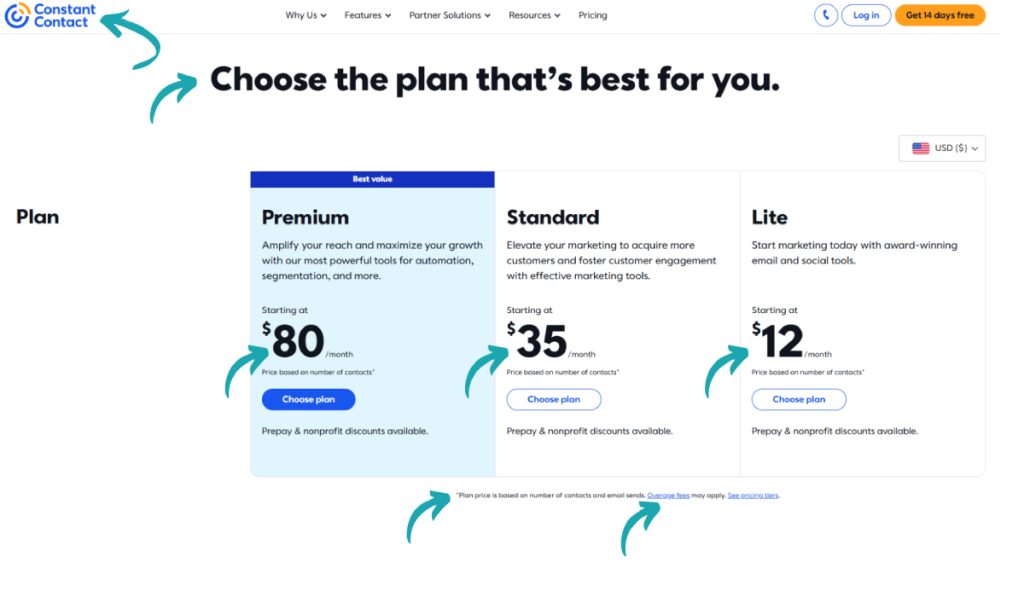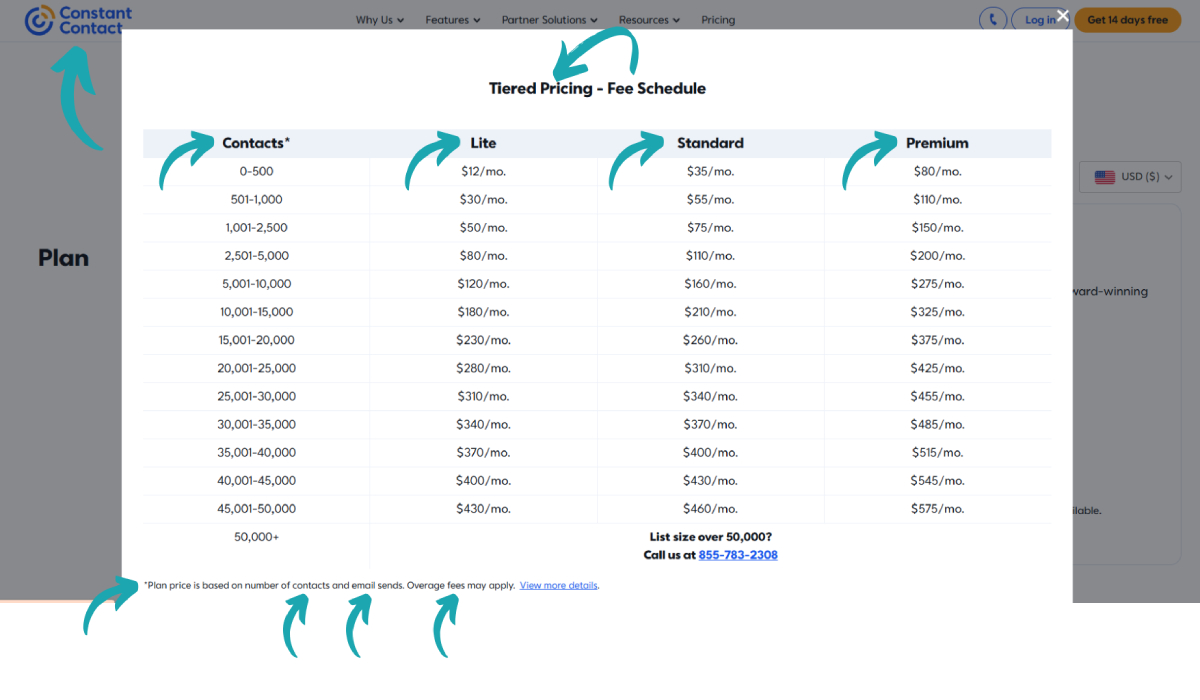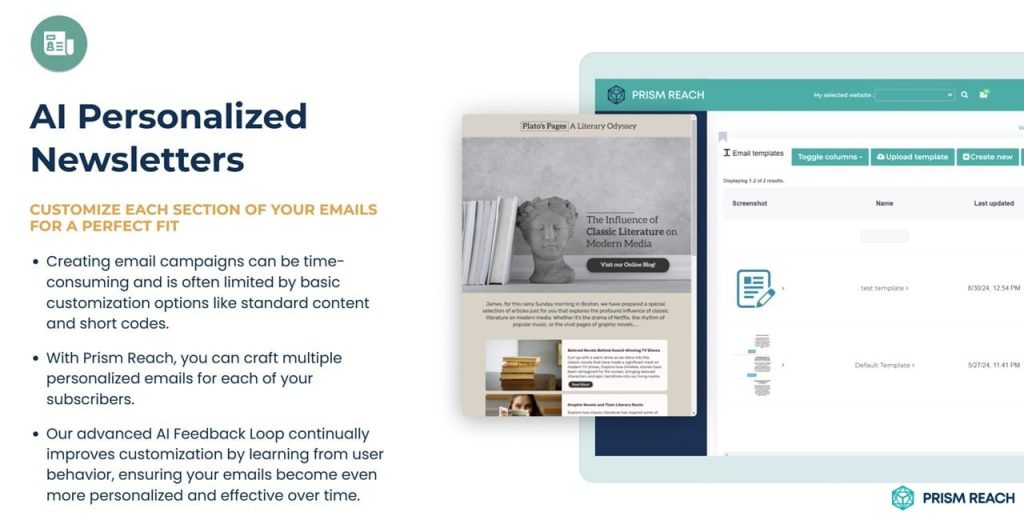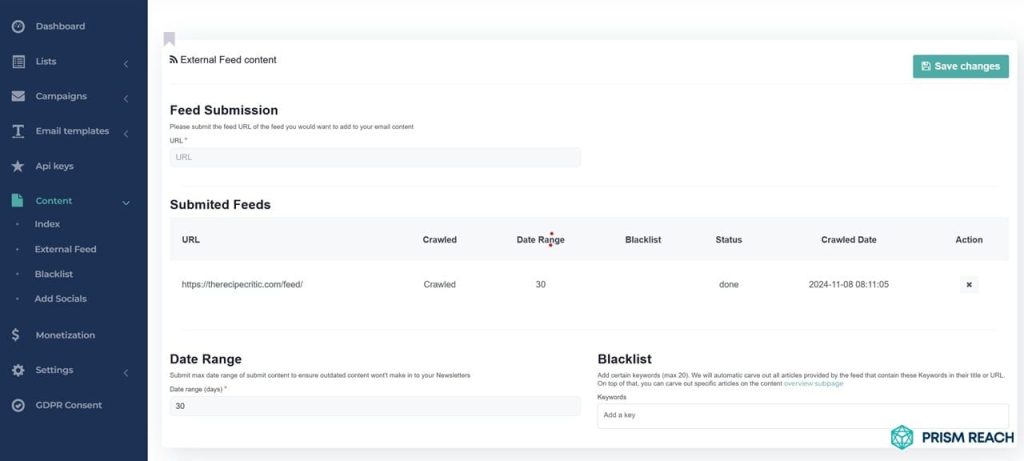In the competitive landscape of digital marketing, email remains a cornerstone strategy for businesses aiming to engage their audience effectively. Among the myriad of tools available, Constant Contact has long been a trusted name, offering robust features to streamline email marketing campaigns. However, as businesses grow and their subscriber lists expand, many users are finding Constant Contact’s pricing model increasingly prohibitive. This article explores the reasons behind these rising costs, compares Constant Contact with alternative solutions, and introduces Prism Reach—a superior, cost-effective alternative designed to meet the needs of growing businesses without breaking the bank.
Key Facts
- Constant Contact’s pricing escalates significantly with the number of contacts, making it expensive for businesses with large subscriber lists.
- Users report that costs can become prohibitively high as their email lists grow, especially when compared to competitors offering unlimited contacts.
- These pricing concerns have led many businesses, particularly those with rapidly expanding subscriber bases, to seek alternative email marketing solutions.
- Prism Reach offers a more flexible and cost-effective solution with unlimited contacts and advanced AI-powered personalization features.
- Implementing strategic cost-management techniques can help businesses maximize their email marketing effectiveness while controlling expenses.
Upgrade Your Email Marketing with AI Personalization!
The Price of Growth: Understanding Constant Contact’s Cost Structure
At the heart of the issue lies Constant Contact’s tiered pricing model, which directly correlates the cost of their service with the size of a user’s contact list. This approach, while straightforward, can lead to unexpected financial burdens for businesses experiencing rapid growth in their subscriber base.
Breaking Down the Numbers
At the core of Constant Contact’s pricing model is a tiered structure that directly correlates costs with the size of a user’s contact list. While this approach is straightforward, it can lead to unexpected financial burdens for businesses experiencing rapid growth in their subscriber base. Here’s a detailed breakdown of Constant Contact’s pricing for their Email plans:
- Lite Plan:
- 0-500 contacts: $12/month
- 501-1,000 contacts: $30/month
- 1,001-2,500 contacts: $50/month
- 2,501-5,000 contacts: $80/month
- 5,001-10,000 contacts: $120/month
- For larger lists:
- 25,001-30,000 contacts: $310/month
- 45,001-50,000 contacts: $430/month
- Premium Plan for 45,001-50,000 contacts: $575/month
For businesses with lists exceeding 50,000 contacts, Constant Contact requires users to contact their sales team directly for custom pricing. This tiered pricing model means that as businesses grow their email lists, they can face significant increases in their monthly costs. This rapid escalation can strain budgets, especially for small to mid-sized businesses and startups.


The Impact on Growing Businesses
For startups and small businesses experiencing rapid growth, Constant Contact’s pricing model can quickly become a significant financial strain. Digital marketing expert Neil Patel aptly states, “Email marketing should scale with your business, not against it. When the cost of reaching your audience outpaces your revenue growth, it’s time to reevaluate your tools.”
This sentiment is echoed across various user reviews and industry forums. On G2, a popular software review platform, one user commented, “We loved Constant Contact initially, but as our subscriber list grew, the costs became unsustainable for our small nonprofit.” Similarly, another user noted, “Our monthly expenses jumped from $100 to over $400 as our list grew to 50,000 contacts. It was no longer justifiable for our budget.”
The escalating costs not only affect the bottom line but also influence strategic decisions. Businesses may hesitate to aggressively grow their email lists, fearing that each new subscriber will lead to higher expenses. This reluctance can stifle marketing efforts, limiting potential reach and engagement.
Comparing to Alternatives
When Constant Contact’s pricing becomes a hurdle, exploring alternative email marketing platforms becomes essential. Competitors like Sendinblue (now Brevo) and MailerLite offer more flexible pricing models that can be more accommodating for growing businesses.
- Sendinblue (Brevo): Offers plans with unlimited contacts, charging instead based on the number of emails sent. For instance, their premium plan at $65/month allows for up to 120,000 emails—a stark contrast to Constant Contact’s tiered pricing based on contact count.
- MailerLite: Provides unlimited emails for up to 10,000 subscribers at $50/month. This pricing is significantly lower than what some users report paying with Constant Contact for similar list sizes.
- Prism Reach: As an emerging AI-powered solution, Prism Reach offers unlimited contacts with flexible pricing based on engagement and usage, ensuring businesses only pay for what they use.
These alternatives not only offer cost savings but also provide features that rival or even surpass those of Constant Contact. For example, Sendinblue’s focus on transactional emails and automation, combined with MailerLite’s user-friendly interface and advanced segmentation, make them attractive options for businesses seeking both functionality and affordability.
The Argument for Value
Defenders of Constant Contact’s pricing structure argue that the platform offers superior features and deliverability rates that justify the cost. John Smith, an email marketing consultant, states, “While the pricing can be steep, Constant Contact’s robust analytics and high deliverability rates can lead to better ROI for some businesses.”
Constant Contact indeed provides a comprehensive suite of tools, including advanced segmentation, detailed analytics, and extensive customer support. These features can be invaluable for businesses that require granular control over their email marketing campaigns. However, the rapid advancement of competing platforms has begun to erode this advantage. Many alternatives now offer comparable, if not superior, features at more competitive prices, challenging the notion that higher costs necessarily equate to higher value.
Moreover, the importance of scalability cannot be overstated. Businesses that anticipate rapid growth need tools that can grow with them without causing budgetary strain. In this context, platforms like Prism Reach, which offer unlimited contacts and AI-driven personalization, provide a more sustainable solution.
The Hidden Costs of Scaling
Beyond the direct financial impact, Constant Contact’s pricing model introduces several hidden costs that can indirectly affect a business’s growth and marketing strategy.
- Stunted Growth: Knowing that each new subscriber will lead to higher costs, businesses may limit their efforts to grow their email lists, missing out on potential engagement and revenue opportunities.
- Resource Allocation: Allocating a significant portion of the marketing budget to email marketing can divert funds from other critical areas, such as content creation, social media marketing, or product development.
- Opportunity Cost: Investing heavily in a platform that may not scale effectively can result in missed opportunities to leverage more efficient and cost-effective tools that could better support business objectives.
These hidden costs highlight the importance of choosing an email marketing platform that not only meets current needs but also accommodates future growth without imposing excessive financial burdens.
User Testimonials
Real-world experiences shed light on the practical implications of Constant Contact’s pricing structure. Here are some user testimonials that illustrate the challenges faced by businesses as their subscriber lists grow:
“We started with Constant Contact and loved it initially, but as our list hit 10,000 subscribers, our monthly cost jumped to nearly $100. It was no longer sustainable for us.”
— Sarah Johnson, Owner of a Small E-commerce Business
“We had to switch from Constant Contact when our list reached 50,000. The cost was approaching $400 per month, which was hard to justify to our finance team, especially when competitors offered unlimited contacts for less.”
— Mark Thompson, Digital Marketing Manager at a Mid-sized B2B Company
“Our nonprofit organization saw significant growth in our email list, but the escalating costs with Constant Contact forced us to explore more affordable alternatives. It was a tough decision, but necessary for our sustainability.”
— Emily Davis, Marketing Director at a Nonprofit Organization
Prism Reach: A Superior Solution to Constant Contact’s Pricing Challenges
In light of the pricing concerns surrounding Constant Contact, Prism Reach emerges as a compelling alternative that addresses these issues head-on. Prism Reach’s innovative AI-powered platform offers a more flexible and cost-effective solution for businesses of all sizes, eliminating the financial strain associated with tiered pricing models.
Key Benefits of Prism Reach
- Unlimited Contacts with Flexible Pricing: Unlike Constant Contact’s tiered system based on contact numbers, Prism Reach offers unlimited contacts across all plans. Pricing is instead based on engagement and actual usage, ensuring that businesses only pay for what they use.
- AI-Driven Personalization: Prism Reach’s advanced AI algorithms optimize email campaigns by personalizing content based on subscriber behavior and preferences. This not only enhances engagement rates but also reduces the need for extensive manual segmentation.
- Cost-Effective Scaling: As your business grows, Prism Reach scales seamlessly without the steep price increases associated with expanding subscriber lists. This ensures that marketing efforts remain sustainable and budget-friendly.

These benefits position Prism Reach as an ideal solution for businesses seeking to maintain effective email marketing campaigns without incurring escalating costs as their subscriber bases expand.
Prism Reach Features Showcase
To provide a clearer understanding of Prism Reach’s functionality and user-friendly design, here are descriptions of potential screenshots that highlight its advanced features:
- Dashboard Overview: A comprehensive dashboard displaying key metrics such as open rates, click-through rates, and subscription growth over time, providing a clear snapshot of campaign performance.
- Pricing Plans Comparison: A visual comparison of Prism Reach’s unlimited contacts pricing versus Constant Contact’s tiered pricing, illustrating the cost savings and flexibility offered by Prism Reach.
- AI-Powered Workflow Setup: An intuitive interface for creating automated email sequences based on user behavior, demonstrating how Prism Reach simplifies complex workflow designs with AI assistance.
Implementing Prism Reach in Your Marketing Strategy
Integrating Prism Reach into your email marketing strategy is a straightforward process that can yield immediate benefits. Here are practical steps to get started:
- Sign Up and Quick Setup: Begin by signing up for Prism Reach and taking advantage of its rapid integration process. Within minutes, you can have the platform up and running, ready to enhance your email marketing efforts.
- Import Your Subscriber List: Utilize the one-click upload feature to seamlessly migrate your existing subscriber lists. This ensures no data loss or downtime, allowing you to maintain continuity in your marketing campaigns.
- Customize Your Newsletters: Use the drag-and-drop editor to personalize your newsletter layout and content. Leverage AI-generated suggestions to create engaging headlines and topics that resonate with your audience.
- Set Up Automated Workflows: Create automated email sequences tailored to user behavior using Prism Reach’s intuitive workflow setup interface. The platform’s AI handles the complexity, allowing you to focus on strategic planning.
- Monitor and Optimize: Use the comprehensive dashboard to track campaign performance and make data-driven decisions. Prism Reach’s analytics provide actionable insights to continuously improve your email marketing efforts.

Maximizing the Benefits of Prism Reach
To fully leverage Prism Reach’s capabilities and maximize your email marketing effectiveness, consider the following tips:
- Personalize Content: Utilize Prism Reach’s AI-driven personalization to tailor content to individual subscriber preferences. This increases engagement and conversion rates by delivering relevant and timely content.
- Optimize Send Times: Take advantage of predictive analytics to determine the best times to send newsletters. Optimizing send times can significantly boost open and click-through rates.
- Leverage Dynamic Content Blocks: Insert automated, audience-tailored content such as trending articles or product suggestions. This keeps your newsletters fresh and relevant, maintaining subscriber interest and engagement.
User Testimonials
Many users have transitioned from Constant Contact to Prism Reach, citing the latter’s ease of use and powerful AI capabilities as significant advantages. Here are some of their experiences:
“Prism Reach has transformed our email marketing strategy. The AI-driven personalization is unparalleled, and the setup was incredibly quick. We’ve seen a 35% increase in engagement since making the switch.”
— Alex Johnson, Marketing Manager at TechSolutions
“As a small business owner, I was overwhelmed by Constant Contact’s complexity. Prism Reach offered a user-friendly alternative that still delivered powerful results. It’s been a game-changer for our campaigns.”
— Maria Lopez, Founder of Crafty Creations
“Our nonprofit organization switched to Prism Reach after struggling with Constant Contact’s escalating costs. Not only did we save money, but our engagement rates also improved significantly thanks to the AI-driven features.”
— David Miller, Director of Marketing at Helping Hands
Future Prospects in Email Marketing Automation
The email marketing landscape is continually evolving, with artificial intelligence and machine learning playing increasingly significant roles in personalization and automation. Tools like Prism Reach are at the forefront of this evolution, offering solutions that balance advanced functionality with user-friendly design.
As businesses seek to create more personalized and effective email campaigns, the demand for tools that simplify the automation process without sacrificing capabilities will grow. Prism Reach’s commitment to continuous improvement of its AI algorithms ensures that it remains a cutting-edge solution in the competitive email marketing space.
Looking ahead, Prism Reach plans to expand its technology into the eCommerce sector and explore new ways to leverage AI for broader marketing applications. This forward-thinking approach positions Prism Reach as not just a tool for today, but a partner for future marketing innovations.
Upgrade Your Email Marketing with AI Personalization!
Conclusion
While Constant Contact has long been a staple in the email marketing industry, its tiered pricing structure for high subscriber counts is increasingly at odds with market expectations and competitor offerings. As businesses grow, the cost of using Constant Contact can escalate rapidly, often outpacing the perceived value of the service. This has led many users to seek alternatives that offer more flexible and cost-effective pricing models, particularly those with unlimited contacts.
Prism Reach emerges as a superior alternative, providing advanced AI-driven personalization and unlimited contacts without the overwhelming complexity and escalating costs associated with Constant Contact. By leveraging AI to understand and predict subscriber preferences, Prism Reach delivers content that is not only relevant but also timely, enhancing the overall impact of digital marketing campaigns and fostering stronger connections between publishers and their audiences.
Ultimately, the choice between depth and ease of use will depend on individual business needs, resources, and long-term marketing strategies. For those seeking a powerful yet user-friendly email marketing solution, Prism Reach offers a compelling option to transform your campaigns and achieve your marketing goals with ease.
Sources
- Constant Contact. (2024). Pricing Plans.
- G2. (2024). Constant Contact Reviews.
- Sendinblue. (2024). Pricing.
- MailerLite. (2024). Pricing.
- ThemeIsle. (2024). Constant Contact Review: Features, Pricing, and Why It’s Expensive.